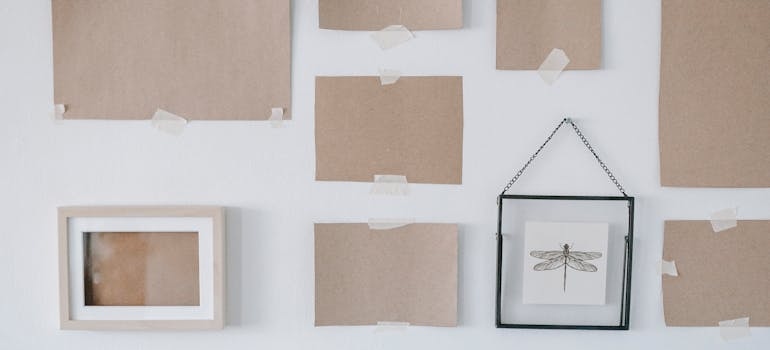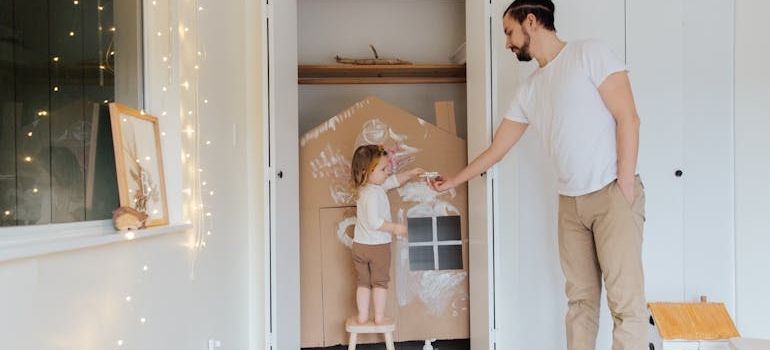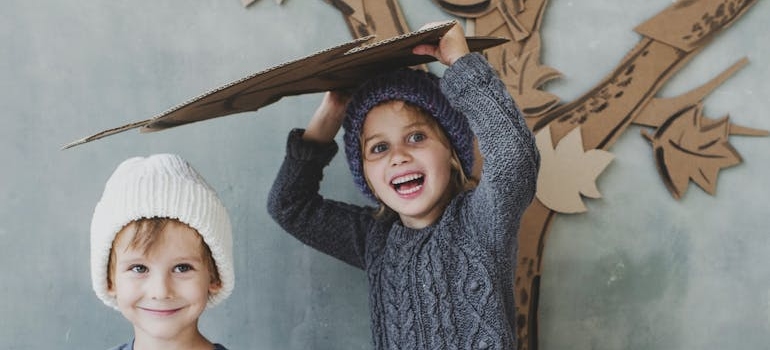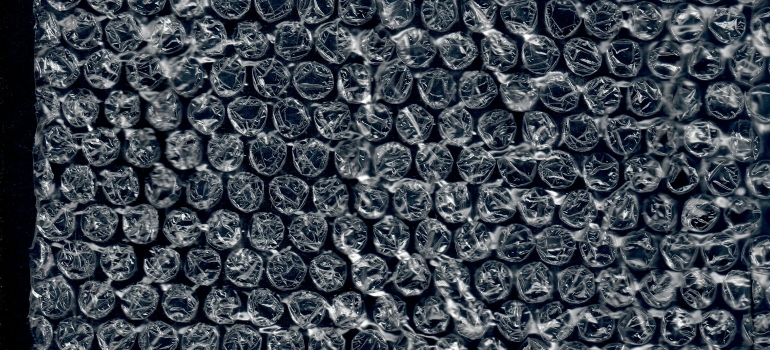What to Do With Leftover Packing Materials
Can you imagine the towering stacks of boxes and the piles of bubble wrap and packing peanuts left after a big move or a series of deliveries? While this scene is common in households and offices around the world, these materials often end up cluttering space or in landfills. Every year, our planet deals with millions of tons of packaging waste, with only a fraction being recycled or reused effectively. However, these leftover materials hold untapped potential—they can be transformed, repurposed, and given a new life in ways that are both creative and sustainable. So, why don’t you explore our guide as we uncover the myriad possibilities hidden in leftover packing materials? Our team from one of the best moving companies Boise has will provide you with practical and imaginative ways to reduce waste and make a positive impact on both your home and the planet!
Essential Recycling Practices for Leftover Packing Materials in Boise, Idaho
Recycling is an essential practice for managing waste effectively, conserving natural resources, and minimizing environmental impact. Proper recycling supports the local economy by sustaining jobs in waste management, reducing landfill use, and decreasing greenhouse gas emissions. So, what are the types of packing materials and their recyclability in Boise?
- Cardboard Boxes: Cardboard is one of the easiest materials to recycle. First, ensure that your Boise moving boxes are free from tape and other contaminants, flatten them, and place them in your curbside recycling bin according to the city’s guidelines.
- Plastic Bubble Wrap and Air Pillows: These are typically not accepted in Boise’s curbside recycling programs because they can entangle in the sorting machinery. Instead, take them to local grocery stores that collect plastic bags and films, as many of these locations also accept bubble wrap and air pillows.
- Packing Peanuts: Often made from Styrofoam, packing peanuts are not accepted in Boise’s curbside recycling. Styrofoam packing material can be reused at many shipping centers or taken to a special facility equipped to handle it.
- Paper Packing Materials: Clean and uncontaminated paper packing materials, such as packing paper and newspapers, are recyclable through Boise’s curbside program. Before recycling, ensure they are dry and free from oil or food waste.
Moreover, Boise has specific recycling rules designed to optimize the efficiency and effectiveness of recycling processes. Residents are encouraged to familiarize themselves with local recycling guidelines, which are readily available on the city’s waste management website. Adhering to these guidelines helps recycle packing material correctly and efficiently, supporting the city’s efforts in waste reduction.

Benefits of Proper Recycling
In Boise, correctly sorting and recycling waste materials helps conserve natural resources such as water, trees, and minerals. It also plays a crucial role in reducing energy consumption and greenhouse gases, as recycled materials generally require less energy to process than manufacturing new products from raw resources.
To streamline the recycling process at home:
- Designate a specific area for collecting recyclables.
- Use separate containers for different materials — one for paper, one for plastics, and another for metals and glass.
- Label each bin clearly to avoid confusion.
- Educate all household members on what can be recycled and how to prepare materials for recycling.
Implementing these practices supports Boise’s environmental goals and fosters a community sustainability culture. Starting with fundamental recycling, you can ensure their efforts to repurpose and reuse packing materials make a significant impact.
Donating and Community Sharing of Packing Materials
When you’ve tackled recycling, consider the benefits of donating or sharing your leftover packing materials. This approach will help you clear out clutter and also aid others in your community by providing resources that can be expensive or difficult to obtain. So, where can you donate packing materials after your local movers in Boise complete their work?
- Local Schools and Libraries: Many educational and community centers in Boise appreciate donations of clean and sturdy boxes for storage or moving needs. Contact local institutions to inquire about their needs.
- Charities and Non-Profits: Organizations such as thrift stores or homeless shelters often need packing materials to store or transport donated goods. Boise has several local charities that welcome these types of donations.
- Art Programs: Some community centers, schools, and non-profits run art programs that use cardboard and other packing materials for crafting and projects. These programs are always on the lookout for supply donations.
But that is not all. Engaging with online platforms to share resources significantly extends the useful life of your packing materials, transforming potential waste into valuable assets for others.
Community Sharing Through Online Platforms and Its Benefits
Platforms such as Freecycle and Craigslist are excellent for this purpose. Listing your available packing materials in Boise’s local community sections on these sites helps declutter your space while providing needed supplies to others who may not have the means to purchase them.
Nextdoor, the neighborhood-focused app, offers a direct way to connect with your Boise neighbors. Posting your available leftover packing materials can quickly transfer them to a new home nearby. This method is convenient and enhances community connections and mutual aid within local neighborhoods. Besides, that approach serves multiple benefits:
- Reduces Waste: By giving materials a second life, you reduce the overall waste sent to landfills.
- Supports Local Community: You provide valuable resources to those in your community who can directly benefit from them.
- Encourages Sustainability: Promoting a culture of reuse aligns with sustainable practices and encourages others to think twice before discarding usable materials.
In other words, these community-focused solutions both help the environment and foster a spirit of cooperation and sustainability in Boise. Through these efforts, residents can make a meaningful difference in both reducing waste and supporting their local community.

Interesting Upcycling Projects for Leftover Packing Materials
In a world increasingly conscious of sustainability, upcycling packing materials presents a creative and environmentally friendly way to repurpose waste. Projects like turning cardboard into decorative storage solutions, transforming foam into garden planters, or using bubble wrap for home insulation add functional and aesthetic value to our living spaces. These upcycling initiatives inspire a rethinking of our approach to what is often considered trash, demonstrating how everyday items can be ingeniously transformed into useful and beautiful new products.
Cardboard Upcycling Ideas
Of all the packing supplies Boise providers offer, moving boxes are the most versatile. Cardboard makes an excellent foundation for creative wall art. Start by cutting the cardboard into your desired shapes—this could be anything from geometric patterns to silhouettes of animals or letters for personalized signs. Once cut, use paint or fabric to decorate your shapes, adding texture and color. Attach the pieces together or hang them individually to create a dynamic and visually appealing display in your home or office.
You can also transform sturdy cardboard packing material into practical shelving for lightweight items such as toys, books, or decorative objects. Measure and cut the cardboard into sides, backs, and shelves. Assemble the pieces using a strong adhesive, making sure each connection is secure. For a finished look, cover the shelves with wrapping paper or paint, then seal with a clear lacquer to add strength and durability. This project not only recycles cardboard but also adds a custom touch to any room.
Keep your workspace tidy with a desk organizer made from recycled cardboard. Cut various pieces of cardboard to create compartments for items like pens, notebooks, and other office supplies. Arrange the compartments in a layout that fits your desk space and needs. Glue the pieces together, and reinforce the corners with additional cardboard or tape for extra stability. Finish by decorating with paint, paper, or fabric to match your office décor.
Build a playhouse out of large cardboard boxes to create an enchanting play area for children. Use multiple boxes for the structure, cutting doors and windows as needed. Secure the boxes together with durable tape and reinforce the edges. Let your kids decorate their playhouse with paint, markers, and stickers.

Foam Upcycling Projects for Gardening in Boise
After moving to Idaho, you can easily transform foam packing materials into lightweight planters perfect for gardening. Simply cut the foam into the size and shape needed for your plants. To enhance durability and aesthetics, wrap the exterior of the foam with weather-resistant fabric or paint it with outdoor paint. Foam planters are ideal for balconies or patios where weight might be a concern. They’re also excellent for indoor use, especially in areas where floor weight capacity is limited.
Foam leftover packing materials are also excellent for creating seed-starting trays. Cut the foam into flat, tray-like shapes with raised edges to hold the soil. Poke small drainage holes at the bottom to allow water to escape. This setup is perfect for starting seeds indoors before the planting season begins. You can place foam trays on windowsills or under grow lights to encourage seedling growth.
As you can guess, gardening can be tough on the knees, but foam packing material can be repurposed into comfortable knee pads. Cut pieces of foam to the size and shape of knee pads, and then encase them in durable fabric. Attach straps using Velcro or sew them directly onto the pads. These custom knee pads will make gardening more comfortable and can reduce strain during long sessions in the garden.
Bubble Wrap Innovations for Home Insulation
Did you know that bubble wrap is an excellent insulator due to the air pockets that provide a barrier against heat loss? To insulate windows, cut the bubble wrap to the size of the window pane, spray a little water on the window, and press the bubble side of the wrap against the glass. This creates an air-filled layer that helps keep the heat in during winter and out during the summer, significantly improving energy efficiency in your home.
Also, wrapping your water heater in bubble wrap can reduce heat loss and improve efficiency. Measure and cut enough bubble wrap to cover the water heater. Secure it with high-temperature tape, ensuring it does not cover any vents or controls. This simple addition can help lower heating costs and extend the life of your water heater by reducing the need to reheat water as often.

Create a draft stopper with bubble wrap to prevent drafts under doors or around windows. Roll a piece of bubble wrap to the length of the door and cover it with a decorative fabric. The bubble wrap provides insulation, and the fabric makes it an attractive addition to your home decor. This is especially useful in older Boise homes where doors may not perfectly align with the floor. These bubble wrap projects offer practical, cost-effective solutions for improving home insulation, reducing energy costs, and enhancing comfort in your living spaces.
Seasonal Crafts
Have you tried using cardboard and foam to create festive decorations during the holiday season? For Halloween, craft spooky silhouettes from cardboard, painting them black and mounting them against windows or on your front porch. During Christmas, transform foam peanut packing material into snow-like decorations for display around your Christmas tree or on your Boise storefront. Just string them together with a fishing line for a snowy garland. After the festivities, keep them at portable storage Boise solutions until next year with other seasonal items.
Reducing Waste, Embracing Resourcefulness and Sustainability
The practice of taking care of leftover packing materials invites us to rethink our approach to what we traditionally see as waste, turning everyday materials into valuable resources. It challenges us to view the items we discard in a new light, uncovering their hidden potential and extending their lifecycle. The projects we’ve explored serve as a blueprint for how households and communities can actively participate in environmental stewardship, fostering a culture of creativity and responsibility.
Moreover, engaging in upcycling can spark a broader dialogue about consumption, waste, and sustainability. It can influence purchasing decisions, encourage consumers to choose products with minimal or reusable packaging, and inspire businesses to adopt greener practices. As more people join this eco-conscious movement, the collective impact can lead to significant environmental improvements.

